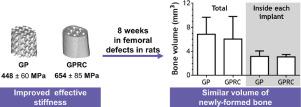当前位置:
X-MOL 学术
›
Acta Biomater.
›
论文详情
Our official English website, www.x-mol.net, welcomes your feedback! (Note: you will need to create a separate account there.)
Custom-made macroporous bioceramic implants based on triply-periodic minimal surfaces for bone defects in load-bearing sites.
Acta Biomaterialia ( IF 9.7 ) Pub Date : 2020-03-17 , DOI: 10.1016/j.actbio.2020.03.016 Baptiste Charbonnier 1 , Mathieu Manassero 2 , Marianne Bourguignon 2 , Adeline Decambron 2 , Hanane El-Hafci 2 , Claire Morin 1 , Diego Leon 1 , Morad Bensidoum 2 , Simon Corsia 2 , Hervé Petite 2 , David Marchat 1 , Esther Potier 2
Acta Biomaterialia ( IF 9.7 ) Pub Date : 2020-03-17 , DOI: 10.1016/j.actbio.2020.03.016 Baptiste Charbonnier 1 , Mathieu Manassero 2 , Marianne Bourguignon 2 , Adeline Decambron 2 , Hanane El-Hafci 2 , Claire Morin 1 , Diego Leon 1 , Morad Bensidoum 2 , Simon Corsia 2 , Hervé Petite 2 , David Marchat 1 , Esther Potier 2
Affiliation

|
The architectural features of synthetic bone grafts are key parameters for regulating cell functions and tissue formation for the successful repair of bone defects. In this regard, macroporous structures based on triply-periodic minimal surfaces (TPMS) are considered to have untapped potential. In the present study, custom-made implants based on a gyroid structure, with (GPRC) and without (GP) a cortical-like reinforcement, were specifically designed to fit an intended bone defect in rat femurs. Sintered hydroxyapatite implants were produced using a dedicated additive manufacturing technology and their morphological, physico-chemical and mechanical features were characterized. The implants' integrity and ability to support bone ingrowth were assessed after 4, 6 and 8 weeks of implantation in a 3-mm-long, femoral defect in Lewis rats. GP and GPRC implants were manufactured with comparable macro- to nano-architectures. Cortical-like reinforcement significantly improved implant effective stiffness and resistance to fracture after implantation. This cortical-like reinforcement also concentrated new bone formation in the core of the GPRC implants, without affecting newly formed bone quantity or maturity. This study showed, for the first time, that custom-made TPMS-based bioceramic implants could be produced and successfully implanted in load-bearing sites. Adding a cortical-like reinforcement (GPRC implants) was a relevant solution to improve implant mechanical resistance, and changed osteogenic mechanism compared to the GP implants. STATEMENT OF SIGNIFICANCE: Architectural features are known to be key parameters for successful bone repair using synthetic bioceramic bone graft. So far, conventional manufacturing techniques, lacking reproducibility and complete control of the implant macro-architecture, impeded the exploration of complex architectures, such as triply periodic minimal surfaces (TPMS), which are foreseen to have an unrivaled potential for bone repair. Using a new additive manufacturing process, macroporous TPMS-based bioceramics implants were produced in calcium phosphate, characterized and implanted in a femoral defect in rats. The results showed, for the first time, that such macroporous implants can be successfully implanted in anatomical load-bearing sites when a cortical-like outer shell is added. This outer shell also concentrated new bone formation in the implant center, without affecting new bone quantity or maturity.
中文翻译:

基于三周期最小表面的定制大孔生物陶瓷植入物,用于承重部位的骨缺损。
合成骨移植物的结构特征是调节细胞功能和组织形成以成功修复骨缺损的关键参数。在这方面,基于三周期最小表面(TPMS)的大孔结构被认为具有未开发的潜力。在本研究中,专门设计了一种基于陀螺结构的定制植入物,其中包含(GPRC)和不包含(GP)皮质样增强材料,以适合大鼠股骨的预期骨缺损。使用专用的增材制造技术生产了烧结的羟基磷灰石植入物,并对它们的形态,物理化学和机械特性进行了表征。在Lewis大鼠的3 mm长的股骨缺损中,在植入4、6和8周后评估植入物的完整性和支持骨向内生长的能力。GP和GPRC植入物的制造具有可比的宏观到纳米架构。类皮质增强材料可显着提高植入物的有效刚度和植入后的抗断裂性。这种皮质状的增强物也将新的骨形成集中在GPRC植入物的核心中,而不会影响新形成的骨量或成熟度。这项研究首次表明,可以生产定制的基于TPMS的生物陶瓷植入物并将其成功植入承重部位。与GP植入物相比,添加皮质样增强材料(GPRC植入物)是提高植入物机械阻力的一种相关解决方案,并且改变了成骨机制。意义声明:已知建筑特征是使用合成生物陶瓷骨移植物成功修复骨的关键参数。到目前为止,传统的制造技术缺乏可重复性和对植入物宏结构的完全控制,阻碍了对复杂体系结构的探索,例如三重周期性最小表面(TPMS),预见其具有无与伦比的骨修复潜力。使用新的增材制造工艺,在磷酸钙中生产了基于大孔TPMS的生物陶瓷植入物,并对其进行了表征并植入了大鼠的股骨缺损中。结果首次显示,当添加皮质状外壳时,这种大孔植入物可以成功地植入解剖结构的承重部位。该外壳还将新的骨形成集中在植入物中心,而不会影响新的骨量或成熟度。缺乏可重复性和对植入物宏结构的完全控制,阻碍了对复杂结构的探索,例如三重周期性最小表面(TPMS),预见其具有无与伦比的骨修复潜力。使用新的增材制造工艺,在磷酸钙中生产了基于大孔TPMS的生物陶瓷植入物,其特征在于并将其植入大鼠股骨缺损中。结果首次表明,当添加皮质状外壳时,这种大孔植入物可以成功地植入解剖结构的承重部位。该外壳还将新的骨形成集中在植入物中心,而不会影响新的骨量或成熟度。缺乏可重复性和对植入物宏结构的完全控制,阻碍了对复杂体系结构的探索,例如三重周期性最小表面(TPMS),预见其具有无与伦比的骨修复潜力。使用新的增材制造工艺,在磷酸钙中生产了基于大孔TPMS的生物陶瓷植入物,并对其进行了表征并植入了大鼠的股骨缺损中。结果首次显示,当添加皮质状外壳时,这种大孔植入物可以成功地植入解剖结构的承重部位。该外壳还将新的骨形成集中在植入物中心,而不会影响新的骨量或成熟度。例如三重周期性最小表面(TPMS),预计它们具有无与伦比的骨修复潜能。使用新的增材制造工艺,在磷酸钙中生产了基于大孔TPMS的生物陶瓷植入物,并对其进行了表征并植入了大鼠的股骨缺损中。结果首次显示,当添加皮质状外壳时,这种大孔植入物可以成功地植入解剖结构的承重部位。该外壳还将新的骨形成集中在植入物中心,而不会影响新的骨量或成熟度。例如三重周期性最小表面(TPMS),预计它们具有无与伦比的骨修复潜能。使用新的增材制造工艺,在磷酸钙中生产了基于大孔TPMS的生物陶瓷植入物,并对其进行了表征并植入了大鼠的股骨缺损中。结果首次显示,当添加皮质状外壳时,这种大孔植入物可以成功地植入解剖结构的承重部位。该外壳还将新的骨形成集中在植入物中心,而不会影响新的骨量或成熟度。结果首次显示,当添加皮质状外壳时,这种大孔植入物可以成功地植入解剖结构的承重部位。该外壳还将新的骨形成集中在植入物中心,而不会影响新的骨量或成熟度。结果首次显示,当添加皮质状外壳时,这种大孔植入物可以成功地植入解剖结构的承重部位。该外壳还将新的骨形成集中在植入物中心,而不会影响新的骨量或成熟度。
更新日期:2020-03-17
中文翻译:

基于三周期最小表面的定制大孔生物陶瓷植入物,用于承重部位的骨缺损。
合成骨移植物的结构特征是调节细胞功能和组织形成以成功修复骨缺损的关键参数。在这方面,基于三周期最小表面(TPMS)的大孔结构被认为具有未开发的潜力。在本研究中,专门设计了一种基于陀螺结构的定制植入物,其中包含(GPRC)和不包含(GP)皮质样增强材料,以适合大鼠股骨的预期骨缺损。使用专用的增材制造技术生产了烧结的羟基磷灰石植入物,并对它们的形态,物理化学和机械特性进行了表征。在Lewis大鼠的3 mm长的股骨缺损中,在植入4、6和8周后评估植入物的完整性和支持骨向内生长的能力。GP和GPRC植入物的制造具有可比的宏观到纳米架构。类皮质增强材料可显着提高植入物的有效刚度和植入后的抗断裂性。这种皮质状的增强物也将新的骨形成集中在GPRC植入物的核心中,而不会影响新形成的骨量或成熟度。这项研究首次表明,可以生产定制的基于TPMS的生物陶瓷植入物并将其成功植入承重部位。与GP植入物相比,添加皮质样增强材料(GPRC植入物)是提高植入物机械阻力的一种相关解决方案,并且改变了成骨机制。意义声明:已知建筑特征是使用合成生物陶瓷骨移植物成功修复骨的关键参数。到目前为止,传统的制造技术缺乏可重复性和对植入物宏结构的完全控制,阻碍了对复杂体系结构的探索,例如三重周期性最小表面(TPMS),预见其具有无与伦比的骨修复潜力。使用新的增材制造工艺,在磷酸钙中生产了基于大孔TPMS的生物陶瓷植入物,并对其进行了表征并植入了大鼠的股骨缺损中。结果首次显示,当添加皮质状外壳时,这种大孔植入物可以成功地植入解剖结构的承重部位。该外壳还将新的骨形成集中在植入物中心,而不会影响新的骨量或成熟度。缺乏可重复性和对植入物宏结构的完全控制,阻碍了对复杂结构的探索,例如三重周期性最小表面(TPMS),预见其具有无与伦比的骨修复潜力。使用新的增材制造工艺,在磷酸钙中生产了基于大孔TPMS的生物陶瓷植入物,其特征在于并将其植入大鼠股骨缺损中。结果首次表明,当添加皮质状外壳时,这种大孔植入物可以成功地植入解剖结构的承重部位。该外壳还将新的骨形成集中在植入物中心,而不会影响新的骨量或成熟度。缺乏可重复性和对植入物宏结构的完全控制,阻碍了对复杂体系结构的探索,例如三重周期性最小表面(TPMS),预见其具有无与伦比的骨修复潜力。使用新的增材制造工艺,在磷酸钙中生产了基于大孔TPMS的生物陶瓷植入物,并对其进行了表征并植入了大鼠的股骨缺损中。结果首次显示,当添加皮质状外壳时,这种大孔植入物可以成功地植入解剖结构的承重部位。该外壳还将新的骨形成集中在植入物中心,而不会影响新的骨量或成熟度。例如三重周期性最小表面(TPMS),预计它们具有无与伦比的骨修复潜能。使用新的增材制造工艺,在磷酸钙中生产了基于大孔TPMS的生物陶瓷植入物,并对其进行了表征并植入了大鼠的股骨缺损中。结果首次显示,当添加皮质状外壳时,这种大孔植入物可以成功地植入解剖结构的承重部位。该外壳还将新的骨形成集中在植入物中心,而不会影响新的骨量或成熟度。例如三重周期性最小表面(TPMS),预计它们具有无与伦比的骨修复潜能。使用新的增材制造工艺,在磷酸钙中生产了基于大孔TPMS的生物陶瓷植入物,并对其进行了表征并植入了大鼠的股骨缺损中。结果首次显示,当添加皮质状外壳时,这种大孔植入物可以成功地植入解剖结构的承重部位。该外壳还将新的骨形成集中在植入物中心,而不会影响新的骨量或成熟度。结果首次显示,当添加皮质状外壳时,这种大孔植入物可以成功地植入解剖结构的承重部位。该外壳还将新的骨形成集中在植入物中心,而不会影响新的骨量或成熟度。结果首次显示,当添加皮质状外壳时,这种大孔植入物可以成功地植入解剖结构的承重部位。该外壳还将新的骨形成集中在植入物中心,而不会影响新的骨量或成熟度。



























 京公网安备 11010802027423号
京公网安备 11010802027423号